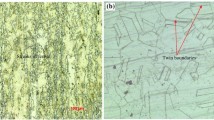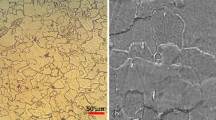Abstract
This article makes an attempt to investigate the outcome of activated flux and filler wire in addition to A-TIG welding and TIG welding of Inconel 625 respectively. Ni-Cr-Mo enriched filler namely ERNiCrMo-3 was used to join 6.5-mm-thick plates. Microstructure characterization, mechanical properties evaluation and secondary dendritic arm spacing measurements were carried out to find the cause of the perceived differences. Tensile test failures were observed at the weld zone in both welding processes. Charpy impact studies showed that weldment using A-TIG revealed a low toughness value compared to the TIG weldment. Root bend test showed no discontinuity in both fusion zones and hence, the weldment was produced without defect. The deleterious laves phase was reduced when activated flux and fillers were used. Corrosion performance was undertaken in a 3.5 wt% NaCl solution, to illustrate the outstanding corrosion resistance in Inconel 625’s fusion zone using A-TIG and TIG welding processes.


























Similar content being viewed by others
References
Special metals corporation products: INCONEL® alloy 625, www.specialmetals.com/products.
Dinda GP, Dasgupta AK, Mazumder J et al (2009) Laser aided direct metal deposition of Inconel 625 superalloy: microstructural evolution and thermal stability. Mater Sci Eng A 509(1-2):98–104
Xu LY, Jing HY, Han YD et al (2018) Effect of welding on the corrosion behavior of X65/Inconel 625 in simulated solution. Weld World 62(2):363–375
Xing X, Di X, Wang B et al (2014) The effect of post-weld heat treatment temperature on the microstructure of Inconel 625 deposited metal. J Alloys Compd 593:110–116
Dupont JN, Lippold JC, Kiser SD et al (2005) Welding metallurgy and weldability of nickel alloys. John Wiley & Sons, Hoboken (NJ)
Cieslak MJ, Headley TJ, Romig AD, Kollie T et al (1988) A melting and solidification study of alloy 625. Metall Trans A 19(9):2319–2331
Tumer M, Karahan T, Mert T et al (2020) Evaluation of microstructural and mechanical properties of dissimilar Inconel 625 nickel alloy– UNS S32205 duplex stainless steel weldment using MIG welding. Weld World 64:21–35
Floreen S, Fuchs GE, Yang WJ et al (1994) The metallurgy of alloy 625. Miner Met Mater Soc:13–37
Manikandan SG, Sivakumar D, Rao KP, Kamaraj M et al (2014) Effect of weld cooling rate on laves phase formation in Inconel 718 fusion zone. J Mater Process Technol 214(2):358–364
Ramkumar KD, Kumar BM, Krishnan MG, Dev S, Bhalodi AJ, Arivazhagan N, Narayanan S et al (2015) Studies on the weldability, microstructure and mechanical properties of activated flux TIG weldments of Inconel 718. Mater Sci Eng A 639:234–244
Radhakrishna CH, Rao KP (1997) The formation and control of laves phase in superalloy 718 welds. J Mater Sci 32(8):1977–1984
S. Kou, Welding metallurgy (2003) New Jersey, USA 431-446.
Tumer M, Mert T, Karahan T et al. (2020) Investigation of microstructure, mechanical, and corrosion behavior of nickel-based alloy 625/duplex stainless steel UNS S32205 dissimilar weldments using ERNiCrMo-3 filler metal. Welding in the World pp.1-12.
Howse DS, Lucas W (2000) Investigation into arc constriction by active fluxes for tungsten inert gas welding. Sci Technol Weld Join 5(3):189–193
Deng D, Murakawa H (2006) Numerical simulation of temperature field and residual stress in multi-pass welds in stainless steel pipe and comparison with experimental measurements. Comput Mater Sci 37(3):269–277
Vasudevan M (2007) Computational and experimental studies on arc welded austenitic stainless steels [PhD Thesis] Indian Institute of Technology, Chennai.
Vasantharaja P, Maduarimuthu V, Vasudevan M, Palanichamy P et al (2012) Assessment of residual stresses and distortion in stainless steel weld joints. Mater Manuf Process 27(12):1376–1381
Sakthivel T, Vasudevan M, Laha K, Parameswaran P, Chandravathi KS, Mathew MD, Bhaduri AK et al (2011) Comparison of creep rupture behaviour of type 316L (N) austenitic stainless steel joints welded by TIG and activated TIG welding processes. Mater Sci Eng A 528(22-23):6971–6980
Tanaka M, Shimizu T, Terasaki T, Ushio M, Koshiishi F (2000) Effects of activating flux on arc phenomena in gas tungsten arc welding. Sci Technol Weld Join 5(6):397–402
Vasudevan M (2017) Effect of A-TIG welding process on the weld attributes of type 304LN and 316LN stainless steels. J Mater Eng Perform 26(3):1325–1336
Ganesh KC, Balasubramanian KR, Vasudevan M, Vasantharaja P, Chandrasekhar N et al (2016) Effect of multipass TIG and activated TIG welding process on the thermo-mechanical behavior of 316LN stainless steel weld joints. Metall Mater Trans B 47(2):1347–1362
Sivakumar J, Vasudevan M, Korra NN et al (2020) Systematic welding process parameter optimization in activated tungsten inert gas (A-TIG) welding of Inconel 625. Trans Indian Inst Metals 73:555–569
Korra NN, Vasudevan M, Balasubramanian KR et al (2015) Multi-objective optimization of activated tungsten inert gas welding of duplex stainless steel using response surface methodology. Int J Adv Manuf Technol 77(1-4):67–81
Pandey C, Mohan Mahapatra M, Kumar P, Saini N et al (2018) Autogenous tungsten inert gas and gas tungsten arc with filler welding of dissimilar P91 and P92 steels. J Press Vessel Technol 140:2
Sivakumar J, Korra NN, Vasantharaja P et al (2020) Computation of residual stresses, distortion, and thermogravimetric analysis of Inconel 625 weld joints. Proc Inst Mech Eng C J Mech Eng Sci. https://doi.org/10.1177/0954406220974058
Anoop K. Unni, Vasudevan Muthukumaran (2020) Numerical simulation of the influence of oxygen content on the weld pool depth during activated TIG welding. Int J Adv Manuf Technol pp 1-23.
Anbarasan N, Jerome S, Arivazhagan N et al (2019) Argon and argon-hydrogen shielding gas effects on the laves phase formation and corrosion behavior of Inconel 718 gas tungsten arc welds. J Mater Process Technol 263:374–384
Acknowledgements
The authors would like to sincerely thank the Director, Metallurgy and Materials Group, Indira Gandhi Centre for Atomic Research (IGCAR), Kalpakkam, for extending the experimental facility and NIT-Tiruchirappalli, Tamilnadu, India, for analytical support.
Author information
Authors and Affiliations
Corresponding author
Additional information
Publisher’s note
Springer Nature remains neutral with regard to jurisdictional claims in published maps and institutional affiliations.
Recommended for publication by Commission XII - Arc Welding Processes and Production Systems
Rights and permissions
About this article
Cite this article
Sivakumar, J., Vasudevan, M. & Korra, N.N. Effect of activated flux tungsten inert gas (A-TIG) welding on the mechanical properties and the metallurgical and corrosion assessment of Inconel 625. Weld World 65, 1061–1077 (2021). https://doi.org/10.1007/s40194-020-01061-4
Received:
Accepted:
Published:
Issue Date:
DOI: https://doi.org/10.1007/s40194-020-01061-4




